Atlanta gibbosa
Roger R. SeapyIntroduction
Atlanta gibbosa is of moderate size (to 4 mm). The shell is completely transparent and colorless, and the walls are thin. The shell surface is smooth, lacking any sculpture. The keel is tall with a truncate leading edge. The keel penetrates between the penultimate and last whorls in shells larger than about 2 mm. The shell spire consists of about 6 whorls and reaches a total of 7-1/2 whorls in full-grown specimens (highest among all Atlanta species). The spire shape is unique among the species with inclined spires; broadly conical with a wide base, a narrow, rounded apex, and an apical angle of about 85°. The spire sutures are moderately deep. The left side of the shell has a conspicuously wide umbilicus. Eyes type b; lens large in adults. Operculum type b, and very thin. Radula type II, with a growth angle of about 15°. Radula with strong sexual dimorphism in width and tooth morphology. The radula is about 25% wider in females than in males. The marginal teeth are much shorter in males than in females, and their shape is very different in males (as sharply-curved, short hooks) than in females (elongate, with more weakly-curved hooks). Also, in the male radula the short pair of marginal teeth leave a conspicuous gap between their hooked ends and those of the lateral teeth. The species is most probably limited to the Indian and Pacific Oceans, and is found in tropical to subtropical waters.Diagnosis
- Maximal shell diameter = 4 mm
- Shell transparent, colorless
- Shell surface smooth, without sculpture
- Keel tall, with truncate leading edge
- Keel penetrates between last two whorls in shells larger than 2 mm
- Spire with about 6 whorls; more than any other Atlanta species
- Spire shape broadly conical, with an apical angle of 85°
- Sutures moderately deep, clearly separating spire whorls
- Left side of shell with a very wide umbilicus
- Eyes type b
- Operculum type b
- Radula type II
- Growth angle of radula about 15°
- Radulae sexually dimorphic; width about 25% wider in females than in males
- Marginal teeth sexually dimorphic; short with sharply-curved hooks in males and elongate with gradually-curved hooks in females
Characteristics
- Shell
- Shell of moderate size (to 4 mm diameter), with up to 7-1/2 whorls (highest among all species of Atlanta)
- Shell transparent and colorless
- Shell fragile, with thin walls
- Keel tall, with a truncate leading edge (see title illustration)
- Keel penetrates between penultimate and last shell whorls in shells with diameters greater than about 2 mm
 Click on an image to view larger version & data in a new window
Click on an image to view larger version & data in a new window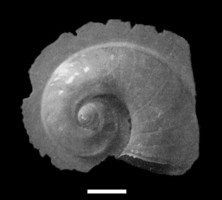
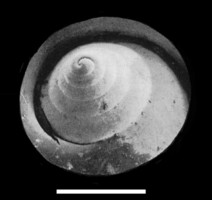
 Click on an image to view larger version & data in a new window
Click on an image to view larger version & data in a new windowFigure. Shell of Atlanta gibbosa, with views of the right side (left) and spire (right). Images from Richter (1972, fig. 1) and Richter (1974, fig. 13, right), modified by addition of scale bars (=1.0 mm and 0.5 mm, respectively). © 1972 and 1974 G. Richter
- Spire only moderately tilted relative to shell plane; lowest among the species of Atlanta with inclined spires
- Spire of about 6 whorls; highest among the species of Atlanta with inclined spires
- Spire conical in side view; with a broad base and a narrow, somewhat rounded apex. Spire with an apical angle of about 85° (Richter, 1990; see SEM below)
- Spire sutures moderately incised, serving to distinctly separate adjacent whorls when shell is viewed from the side (see second SEM from top and larval shell SEM above)
- Internal walls of spire intact (see transmitted light photograph below); not decalcified as in A. inclinata and A. tokiokai
- Left side of shell with unusually wide umbilicus (see second SEM below)
 Click on an image to view larger version & data in a new window
Click on an image to view larger version & data in a new window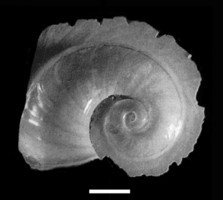
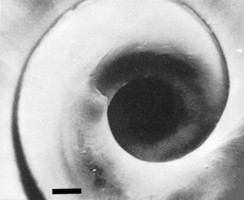
Figure. Shell of Atlanta gibbosa; views of the left side (left) and the umbilical region (right). Images from Richter (1972, fig. 1, lower) and Richter (1990, fig. 18), respectively, modified by addition of scale bars (= 1 mm and 100 µm, respectively). © 1972 and 1990 G. Richter
- Shell of moderate size (to 4 mm diameter), with up to 7-1/2 whorls (highest among all species of Atlanta)
- Eyes type b
- Lens conspicuously large in adults, suggesting that the species prefers deeper daytime depths (Richter, 1974)
- Lens conspicuously large in adults, suggesting that the species prefers deeper daytime depths (Richter, 1974)
- Operculum type b
- Operculum very thin
- Radula type II
- Radula with a growth angle of about 15°
- Sexual dimorphism in radula width; about 25% greater in females than in males (see SEMs below)
- Sexual dimorphism in marginal teeth shape and length; in males they are short and form sharply-curved hooks, while in females they are elongate and more gradually-curved (see the two SEMs, respectively, above)
- Rachidian teeth with a broad, low basal plate and a long, slender cusp (see SEM below). Tooth width comparable with that in A. meteori, but about 40% wider than in A. inclinata and about 75% wider than in A. tokiokai (Richter, 1990)
Comments
Atlanta gibbosa and A. meteori comprise the Atlanta gibbosa species group. The two species share a series of characters (summarized in Richter and Seapy, 1999): (1) shell is transparent, colorless, and fragile with thin walls, (2) keel is tall, with a truncate leading edge, (3) keel penetrates between the penultimate and last whorls in shells larger than about 2 mm, (4) eyes are type b, (5) lens of the eye in adults is conspicuously large, suggesting that the species prefers greater daytime depths (Richter, 1974), (6) operculum is type b, (7) radula is type II, with a moderate growth angle of 12-15°, (8) lateral teeth are relatively straight; not noticeably curved as in most species, and (9) rachidian teeth are wide, with a broad base; considerably wider than in the Atlanta inclinata species group. The two species differ in: (1) spire shape, which is broadly conical (apical angle about 85°) and with a narrow apex in A. gibbosa, and narrowly conical (apical angle 60-70°) and with a rounded apex in A. meteori, (2) spire sutures incised, forming distinct sutures in the former species, and shallow, resulting a nearly smooth spire surface in the latter one, (3) umbilicus conspicuously wider in the former than in the latter species.
Atlanta gibbosa has been recorded from the Indian and Pacific Oceans, although it has not been reported from the Atlantic Ocean with the exception of a single record by Souleyet (1852) that cannot be verified from voucher material (discussed by Richter, 1990).
References
Richter, G. 1972. Zur Kenntnis der Gattung Atlanta (Heteropoda: Atlantidae). Archiv für Molluskenkunde 102(1/3): 85-91.
Richter, G. 1974. Die Heteropoden der "Meteor" Expedition in den Indischen Ozean 1964/65. "Meteor" Forschungs-Ergibnisse Ser. D, No. 17, pp. 55-78.
Richter, G. 1990. Zur Kenntnis der Gattung Atlanta (IV). Die Atlanta inclinata-Gruppe (Prosobranchia: Heteropoda). Archiv für Molluskenkunde 119: 239-275.
Richter, G. and R. R. Seapy. 1999. Heteropoda, pp. 621-647. In: D. Boltovskoy (ed.), South Atlantic Zooplankton. Backhuys Publishers, Leiden.
Souleyet, L. F. A. 1852. Heteropodes, pp. 289-392. In: J. F. T. Eydoux and L. F. A. Souleyet, Voyage autour du monde exécuté pendant les années 1836 et 1837 sur la corvette 'La Bonite', commandée par M. Vaillant, capitaine de vaisseau, publié par ordre du Gouvernement sous les auspices du Département de la marine. Zoologie, 2. Atlas. A. Bertrand (ed), Société de Géographie, Paris.
About This Page

California State University, Fullerton, California, USA
Correspondence regarding this page should be directed to Roger R. Seapy at
Page copyright © 2011
 Page: Tree of Life
Atlanta gibbosa .
Authored by
Roger R. Seapy.
The TEXT of this page is licensed under the
Creative Commons Attribution License - Version 3.0. Note that images and other media
featured on this page are each governed by their own license, and they may or may not be available
for reuse. Click on an image or a media link to access the media data window, which provides the
relevant licensing information. For the general terms and conditions of ToL material reuse and
redistribution, please see the Tree of Life Copyright
Policies.
Page: Tree of Life
Atlanta gibbosa .
Authored by
Roger R. Seapy.
The TEXT of this page is licensed under the
Creative Commons Attribution License - Version 3.0. Note that images and other media
featured on this page are each governed by their own license, and they may or may not be available
for reuse. Click on an image or a media link to access the media data window, which provides the
relevant licensing information. For the general terms and conditions of ToL material reuse and
redistribution, please see the Tree of Life Copyright
Policies.
- First online 17 July 2010
- Content changed 23 July 2011
Citing this page:
Seapy, Roger R. 2011. Atlanta gibbosa . Version 23 July 2011 (under construction). http://tolweb.org/Atlanta_gibbosa/28761/2011.07.23 in The Tree of Life Web Project, http://tolweb.org/




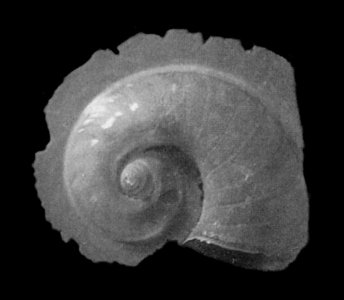

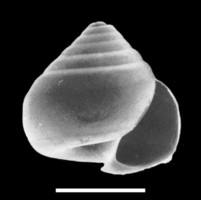
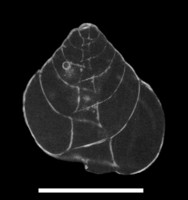
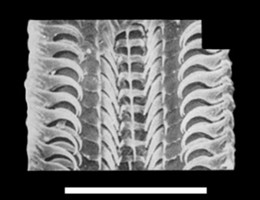
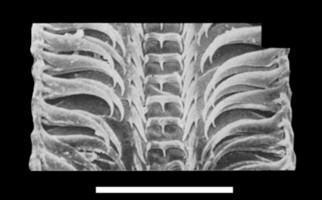
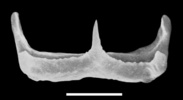
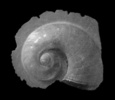


 Go to quick links
Go to quick search
Go to navigation for this section of the ToL site
Go to detailed links for the ToL site
Go to quick links
Go to quick search
Go to navigation for this section of the ToL site
Go to detailed links for the ToL site